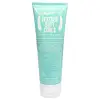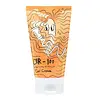What's inside
What's inside
 Benefits
Benefits

 Concerns
Concerns

 Ingredients Side-by-side
Ingredients Side-by-side

Water
Skin ConditioningGlycerin
HumectantEmulsifying Wax Nf
Amodimethicone
Cetrimonium Chloride
AntimicrobialTrideceth-12
EmulsifyingBehentrimonium Chloride
PreservativeHamamelis Virginiana Water
AstringentAloe Barbadensis Leaf Extract
EmollientHydrolyzed Wheat Protein/Pvp Crosspolymer
Triticum Vulgare Germ Oil
EmollientPersea Gratissima Oil
Skin ConditioningCarthamus Tinctorius Seed Oil
MaskingGuar Hydroxypropyltrimonium Chloride
Skin ConditioningHydroxypropyl Methylcellulose
Emulsion StabilisingMethyl Gluceth-20
HumectantSilk Amino Acids
HumectantEthylhexyl Methoxycinnamate
UV AbsorberPhenoxyethanol
PreservativeCaprylyl Glycol
EmollientCitric Acid
BufferingParfum
MaskingHc Yellow No. 10
Water, Glycerin, Emulsifying Wax Nf, Amodimethicone, Cetrimonium Chloride, Trideceth-12, Behentrimonium Chloride, Hamamelis Virginiana Water, Aloe Barbadensis Leaf Extract, Hydrolyzed Wheat Protein/Pvp Crosspolymer, Triticum Vulgare Germ Oil, Persea Gratissima Oil, Carthamus Tinctorius Seed Oil, Guar Hydroxypropyltrimonium Chloride, Hydroxypropyl Methylcellulose, Methyl Gluceth-20, Silk Amino Acids, Ethylhexyl Methoxycinnamate, Phenoxyethanol, Caprylyl Glycol, Citric Acid, Parfum, Hc Yellow No. 10
Water
Skin ConditioningPropylene Glycol
HumectantCyclopentasiloxane
EmollientDimethicone
EmollientGlycerin
HumectantPvp
Emulsion StabilisingPolyacrylamide
Hydroxyethyl Acrylate/Sodium Acryloyldimethyl Taurate Copolymer
Emulsion StabilisingParfum
MaskingC13-14 Isoparaffin
EmollientTromethamine
Buffering1,2-Hexanediol
Skin ConditioningCaprylyl Glycol
EmollientButylene Glycol
HumectantLaureth-7
EmulsifyingSodium Acrylate/Sodium Acryloyldimethyl Taurate Copolymer
Emulsion StabilisingIsohexadecane
EmollientIllicium Verum Fruit Extract
PerfumingPhenoxyethanol
PreservativePolysorbate 80
EmulsifyingDisodium EDTA
Oenothera Biennis Oil
EmollientArgania Spinosa Kernel Oil
EmollientChamomilla Recutita Flower Oil
MaskingSorbitan Oleate
EmulsifyingCyclomethicone
EmollientHydrolyzed Collagen
EmollientGelatin
Hydrolyzed Keratin
HumectantAvena Sativa Protein Extract
Skin ConditioningRosmarinus Officinalis Leaf Extract
AntimicrobialLavandula Angustifolia Flower Extract
CleansingThymus Vulgaris Flower/Leaf/Stem Extract
Skin ConditioningOriganum Vulgare Extract
Skin ConditioningHydrolyzed Corn Protein
Skin ConditioningHydrolyzed Wheat Protein
Skin ConditioningHydrolyzed Soy Protein
HumectantWater, Propylene Glycol, Cyclopentasiloxane, Dimethicone, Glycerin, Pvp, Polyacrylamide, Hydroxyethyl Acrylate/Sodium Acryloyldimethyl Taurate Copolymer, Parfum, C13-14 Isoparaffin, Tromethamine, 1,2-Hexanediol, Caprylyl Glycol, Butylene Glycol, Laureth-7, Sodium Acrylate/Sodium Acryloyldimethyl Taurate Copolymer, Isohexadecane, Illicium Verum Fruit Extract, Phenoxyethanol, Polysorbate 80, Disodium EDTA, Oenothera Biennis Oil, Argania Spinosa Kernel Oil, Chamomilla Recutita Flower Oil, Sorbitan Oleate, Cyclomethicone, Hydrolyzed Collagen, Gelatin, Hydrolyzed Keratin, Avena Sativa Protein Extract, Rosmarinus Officinalis Leaf Extract, Lavandula Angustifolia Flower Extract, Thymus Vulgaris Flower/Leaf/Stem Extract, Origanum Vulgare Extract, Hydrolyzed Corn Protein, Hydrolyzed Wheat Protein, Hydrolyzed Soy Protein
 Reviews
Reviews

Ingredients Explained
These ingredients are found in both products.
Ingredients higher up in an ingredient list are typically present in a larger amount.
Caprylyl Glycol is a humectant and emollient, meaning it attracts and preserves moisture.
It is a common ingredient in many products, especially those designed to hydrate skin. The primary benefits are retaining moisture, skin softening, and promoting a healthy skin barrier.
Though Caprylyl Glycol is an alcohol derived from fatty acids, it is not the kind that can dry out skin.
This ingredient is also used as a preservative to extend the life of products. It has slight antimicrobial properties.
Learn more about Caprylyl GlycolGlycerin is already naturally found in your skin. It helps moisturize and protect your skin.
A study from 2016 found glycerin to be more effective as a humectant than AHAs and hyaluronic acid.
As a humectant, it helps the skin stay hydrated by pulling moisture to your skin. The low molecular weight of glycerin allows it to pull moisture into the deeper layers of your skin.
Hydrated skin improves your skin barrier; Your skin barrier helps protect against irritants and bacteria.
Glycerin has also been found to have antimicrobial and antiviral properties. Due to these properties, glycerin is often used in wound and burn treatments.
In cosmetics, glycerin is usually derived from plants such as soybean or palm. However, it can also be sourced from animals, such as tallow or animal fat.
This ingredient is organic, colorless, odorless, and non-toxic.
Glycerin is the name for this ingredient in American English. British English uses Glycerol/Glycerine.
Learn more about GlycerinParfum is a catch-all term for an ingredient or more that is used to give a scent to products.
Also called "fragrance", this ingredient can be a blend of hundreds of chemicals or plant oils. This means every product with "fragrance" or "parfum" in the ingredients list is a different mixture.
For instance, Habanolide is a proprietary trade name for a specific aroma chemical. When used as a fragrance ingredient in cosmetics, most aroma chemicals fall under the broad labeling category of “FRAGRANCE” or “PARFUM” according to EU and US regulations.
The term 'parfum' or 'fragrance' is not regulated in many countries. In many cases, it is up to the brand to define this term.
For instance, many brands choose to label themselves as "fragrance-free" because they are not using synthetic fragrances. However, their products may still contain ingredients such as essential oils that are considered a fragrance by INCI standards.
One example is Calendula flower extract. Calendula is an essential oil that still imparts a scent or 'fragrance'.
Depending on the blend, the ingredients in the mixture can cause allergies and sensitivities on the skin. Some ingredients that are known EU allergens include linalool and citronellol.
Parfum can also be used to mask or cover an unpleasant scent.
The bottom line is: not all fragrances/parfum/ingredients are created equally. If you are worried about fragrances, we recommend taking a closer look at an ingredient. And of course, we always recommend speaking with a professional.
Learn more about ParfumPhenoxyethanol is a preservative that has germicide, antimicrobial, and aromatic properties. Studies show that phenoxyethanol can prevent microbial growth. By itself, it has a scent that is similar to that of a rose.
It's often used in formulations along with Caprylyl Glycol to preserve the shelf life of products.
Water. It's the most common cosmetic ingredient of all. You'll usually see it at the top of ingredient lists, meaning that it makes up the largest part of the product.
So why is it so popular? Water most often acts as a solvent - this means that it helps dissolve other ingredients into the formulation.
You'll also recognize water as that liquid we all need to stay alive. If you see this, drink a glass of water. Stay hydrated!
Learn more about Water